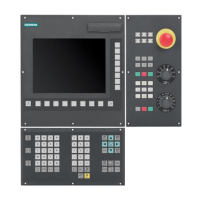Gantry axes (G1)
6.4 Start-up of gantry axes
Turning, Milling, Nibbling
100 Function Manual, 11/2012, 6FC5397-1CP10-5BA0
MD37130 GANTRY_POS_TOL_REF (gantry trip limit for referencing)
Note
The control must then be switched off and then on again because the gantry axis definition
and the trip limit values only take effect after power ON.
Response to setpoint changes and disturbances
The gantry axes can only operate in exact synchronism if the parameters for the control
circuits of the leading and synchronized axes are set to the same dynamic response value.
The axial control loops (position, speed and current controllers) should each be set to the
optimum value so that disturbances can be eliminated as quickly and efficiently as possible.
The dynamic response adaptation function in the setpoint branch is provided to allow
differing dynamic responses of axes to be matched without loss of control quality.
The following control parameters must be set to the optimum axial value for both the leading
axis and the synchronized axis:
● MD32200 POSCTRL_GAIN (servo gain factor)
● MD32620 FFW_MODE (precontrol parameter)
● MD32610 VELO_FFW_WEIGHT (precontrol factor for acceleration/speed precontrol)
● MD32810 EQUIV_SPEEDCTRL_TIME (equivalent time constant speed control loop for
precontrol)
The following control parameters must be set to the same value for the leading axis and
synchronized axis:
● MD32400 AX_JERK_ENABLE (axial jerk limitation)
● MD32410 AX_JERK_TIME (time constant for the axial jerk filter)
● MD32420 JOG_AND_POS_JERK_ENABLE (basic setting for axial jerk limitation)
● MD32430 $MA_JOG_AND_POS_MAX_JERK (axial jerk)
Dynamics matching
The leading axis and the coupled synchronized axis must be capable of the same dynamic
response to setpoint changes. The same dynamic response means: The following errors are
equal in magnitude when the axes are operating at the same speed.
The dynamic response adaptation function in the setpoint branch makes it possible to obtain
an excellent match in the response to setpoint changes between axes, which have different
dynamic characteristics (control loops). The difference in equivalent time constants between
the dynamically "weakest" axis and the other axis in each case must be specified as the
dynamic response adaptation time constant.

